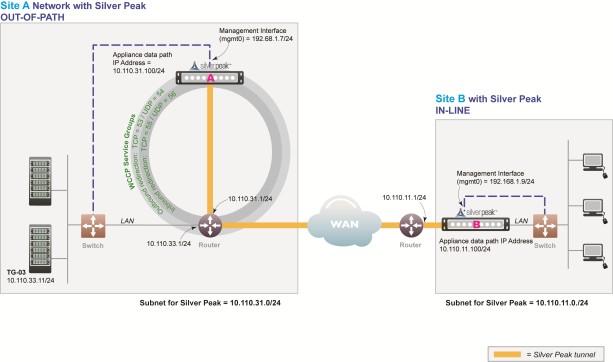Web Cache Communication Protocol (WCCP)
WCCPWeb Cache Communications Protocol. A Cisco-developed content-routing protocol that provides a mechanism to redirect traffic flows in real-time. It has built-in load balancing, scaling, fault tolerance, and service-assurance (failsafe) mechanisms. Utilizes HIA (Here I Am) messages from SP devices and ISY (I See You) messages to the router. is configured on both the router and the Silver Peak appliance. Also, configure WCCP for redundancy and load balancingA technique to spread work between two or more computers, network links, CPUs, hard drives, or other resources, in order to get optimal resource utilization, maximize throughput, and minimize response time. Using multiple components with load balancing, instead of a single component, may increase reliability through redundancy. The balancing service is usually provided by a dedicated program or hardware device..
In the following scenario, the Silver Peak appliances are not connected in the direct path of the network traffic. As a result, a network traffic redirection technique is used to forward traffic to the appliance.
WCCP supports the redirection of any TCPTransmission Control Protocol. The error-correcting Transport layer (Layer-4) in the TCP/IP protocol suite. It ensures that all data arrive at the other end accurately and completely intact. or UDPUser Datagram Protocol. Part of the TCP/IP protocol suite, it was created to provide a way for applications to access the connectionless features of IP. UDP provides for exchange of datagrams without acknowledgements or guaranteed delivery. connections to appliances participating in WCCP Service Groups. The appliance intercepts only those packets that have been redirected to it. The appliance accelerates traffic flows that the Route Policy directs to a tunnelEncapsulating one type of network protocol (called the payload protocol) within a different delivery protocol. A logical connection between two devices, in our case, two Silver Peak appliances.; all other traffic passes through the appliance unmodified. (Traffic might be dropped depending on overlay action for the default overlay.)
In the unlikely event that the appliance fails, WCCP on the WANWide Area Network router removes the appliance from the WCCP Service Group and resumes forwarding traffic normally, according to its routing tables.
At Site A, both the router and the participating appliance require a separate WCCP service group for each protocol used in the tunnel. So, if a tunnel uses both TCP and UDP, you must create a separate WCCP Service Group for each protocol (TCP and UDP) used in the A-to-B tunnel.

Figure 1. WCCP Network
In this example, the Silver Peak appliances optimize traffic to/from 10.110.33.0/24 and 10.110.11.0/24.
|
NOTE You don’t need a spare router port for this configuration. The Silver Peak appliance can be connected to an existing or newly configured sub-interface on the router via a VLANVirtual Local Area Network. A means by which LAN users on different physical LAN segments are afforded priority access privileges across the LAN backbone so that they appear to be on the same physical segment of an enterprise-level logical LAN. trunk such that a spare port on the LANLocal Area Network. switchA network device that filters and forwards frames based on the destination address of each frame. The switch operates at Layer-2 (data link layer) of the Open System Interconnection (OSI) model. can be used for the physical connection. |
